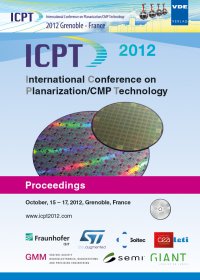Tribological, Thermal, and Kinetic Attributes of 300 vs. 450 mm Chemical Mechanical Planarization Processes
Konferenz: ICPT 2012 - International Conference on Planarization / CMP Technology
15.10.2012-17.10.2012 in Grenoble, France
Tagungsband: ICPT 2012
Seiten: 6Sprache: EnglischTyp: PDF
Persönliche VDE-Mitglieder erhalten auf diesen Artikel 10% Rabatt
Autoren:
Jiao, Yubo; Liao, Xiaoyan; Wu, Changhong (Department of Chemical and Environmental Engineering, University of Arizona, Tucson, AZ 85721, USA)
Zhuang, Yun; Sampurno, Yasa; Philipossian, Ara (Department of Chemical and Environmental Engineering, University of Arizona, Tucson, AZ 85721, USA )
Theng, Siannie (Araca, Inc., Tucson, AZ 85718, USA)
Godlstein, Michael (Intel Corporation, Santa Clara, CA 95052, USA)
Inhalt:
An existing 300 mm CMP tool has been modified to polish 450 mm wafers in order to demonstrate experimentally whether any differences exist in the tribological and thermal characteristics of the two processes, and from that, to infer whether one can expect any removal rate differences between the two systems. Results suggest that, within the ranges of parameter investigated, the two systems behave similarly in terms of their coefficients of friction and lubrication regimes. Additionally, it is shown that the 450 mm process, once adjusted for its platen velocity, runs only slightly warmer (by 1 to 2 °C) than its 300 mm counterpart. Experimental data, coupled with copper removal rate simulations show that the wafer surface reaction temperatures of the 450 mm adjusted process are higher (by 2 to 3 °C) than the 300 mm process. Consequently, simulated copper removal rates for the 450 mm adjusted process are higher (by 8 to 31%) than those of the 300 mm process. Keywords: Chemical Mechanical Polishing, 300 vs. 450 mm, Coefficient of Friction, Wafer Surface Reaction Temperature, Removal Rate


